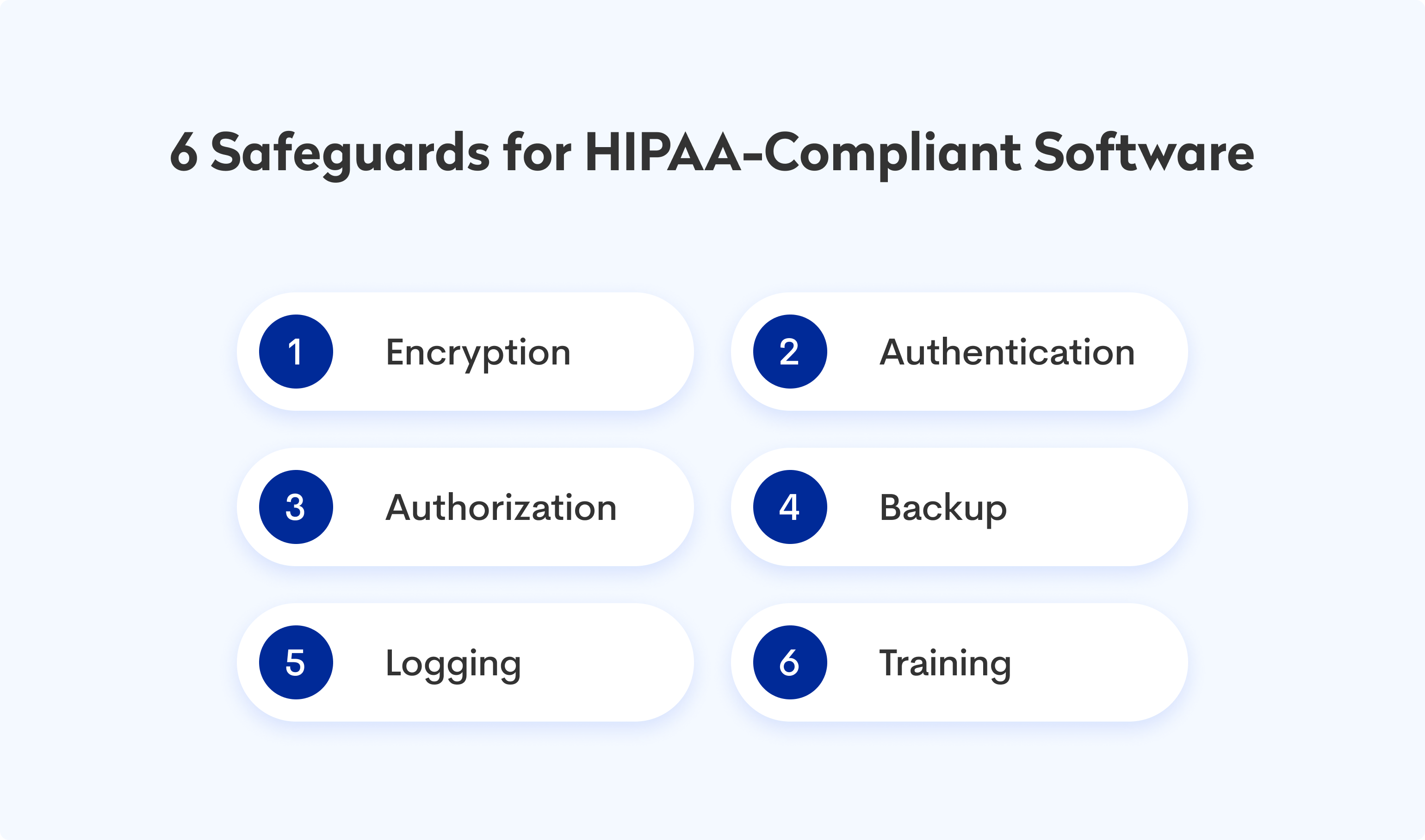
How to Build a Custom HIPAA-Compliant Software for Therapists?
Have you ever experimented with off-the-shelf software solutions only to find inadequate functionality or security? If so, consider developing bespoke HIPAA-compliant software explicitly tailored to your psychology practice. It offers a unique solution to meet your specific needs and objectives. It can be a powerful tool to gain a competitive advantage and elevate your business to the next level.
This blog post delves into the many benefits of custom software to psychologists in private practice. Additionally, we take you through the process of developing HIPAA-compliant software by leveraging the expertise of a professional software development company. Let’s explore how custom software will revolutionize your psychology practice and drive remarkable results.
Table of Contents
Why is HIPAA compliance important?
A critical aspect when developing custom software for psychologists in private practice is ensuring compliance with HIPAA and other regulations to protect your client’s health information.
HIPAA (Health Insurance Portability and Accountability Act) represents federal legislation that establishes regulations governing the handling and safeguarding of protected health information (PHI) by healthcare providers and other relevant entities.
PHI encompasses any data used to identify an individual which concerns their physical or mental well-being, medical care, or payment for such services.
When is HIPAA compliance required? As a psychologist, you fall under the category of covered entities as defined by HIPAA. This implies you are obligated to adhere to the provisions outlined in the HIPAA Privacy Rule and the HIPAA Security Rule.
The Privacy Rule outlines your responsibilities concerning the usage and disclosure of PHI. This includes obtaining consent from your clients, providing them with a notice outlining your privacy practices, and upholding their rights to access and make record amendments.
Comparably, the Security Rule necessitates the implementation of technical and administrative safeguards ensuring the confidentiality and integrity of electronic PHI (e-PHI).
Non-compliance with HIPAA regulations can result in severe consequences, including monetary penalties, legal actions, audits, and damage to your professional reputation.
According to a report by IBM Security, the average cost of healthcare data breaches in 2021 surged to $9.3 million per incident – a 29.5 percent increase from the previous year’s average of $7.13 million. Therefore, it is essential to develop custom software that meets HIPAA compliance requirements and protects your clients’ data from unauthorized access or misuse.
How to Make Software HIPAA-compliant?
Before commencing the development of your customized software solution, it is crucial to establish a well-defined plan that effectively addresses the requirements of your psychology practice while ensuring compliance with HIPAA and other pertinent regulations.
A comprehensive plan acts as a roadmap and prevents wasting valuable time and resources on unnecessary functionalities, mitigating scope creep, and guaranteeing the delivery of a high-quality, secure solution.
Defining the Scope of Work
The initial step demands the creation of a concise overview outlining the developmental aspects of the HIPAA-compliant software. Ideally, it encompasses the project’s objectives, deliverables, timeline, budget, and specifications.
Furthermore, it is essential to identify the key stakeholders and clearly define the roles and responsibilities of each team member involved in the project. By crafting a well-structured plan, you set a solid foundation for successfully developing and implementing your software solution.
Conduct User Research
The second step is understanding how private practice psychologists use technology and their pain points and needs. You should conduct user research by interviewing potential users, observing their workflows, and analyzing their feedback. You can also review existing software solutions and identify strengths and weaknesses. This helps you understand the features your custom software should offer to solve your users’ problems.
Participate in Product Workshops
Product workshops are interactive sessions enabling you to delve into different aspects of your product idea. Techniques such as Value Proposition Canvas and Event Storming determine user problems, map out application workflows, and define the essential features of your product. Additionally, competitor analysis and generating innovative solutions also form part of the workshop experience. By participating in product workshops facilitated by Blurify, you gain access to customized methodologies and expert guidance. This enables you to refine your ideas, make well-informed decisions, and set your projects on a path to success.
Conduct a Risk Analysis and a Gap Analysis
The third step is to conduct a risk analysis and a gap analysis to identify potential threats and vulnerabilities to PHI and the current state of compliance. A comprehensive risk analysis is a systematic process that involves evaluating various risks’ probability and potential impact. Similarly, a gap analysis is ideal for comparing your current practices and capabilities against desired or mandated standards and industry best practices.
By undertaking these analyses, you effectively identify areas needing improvement within your security measures, such as encryption, access control, backup systems, or monitoring protocols. Furthermore, these assessments enable you to prioritize the necessary actions to mitigate or eliminate risks and bridge any identified gaps.
Implementation of Technical and Administrative Safeguards
For the fourth step, it is imperative to implement the technical and administrative safeguards mandated by HIPAA. This involves safeguarding the confidentiality and integrity of electronically protected health information (e-PHI) you generate, receive, store, or transmit through your software systems.
Furthermore, it incorporates a range of protective measures, including robust and HIPAA-compliant encryption protocols, stringent access control mechanisms, reliable backup systems, and comprehensive monitoring frameworks. By diligently adhering to these safeguards, you ensure that sensitive data within your software remains protected per HIPAA requirements.
Administrative safeguards are the policies and procedures which manage the selection, development, implementation, and maintenance of security measures to protect e-PHI and the conduct of the entity’s workforce concerning protecting that information. Some examples of technical safeguards are encryption, authentication, authorization, backup, logging, and monitoring.
Administrative safeguards include risk analysis, management, training, audits, and incident response. You should implement these safeguards according to your risk analysis and gap analysis results and in alignment with your software specifications and requirements.
How to Build Your Custom HIPAA-Compliant Software for Your Psychology Practice?
After you have planned your custom software project, you must build or configure your software to meet the needs of your psychology practice and comply with HIPAA and other regulations. This involves implementing technical and administrative safeguards protecting the privacy and security of PHI. Some of these safeguards include:
Encryption
You should encrypt PHI at rest and in transit using robust encryption algorithms and keys. Encryption prevents unauthorized access to PHI, even if it is stolen or intercepted.
Authentication
You should verify the identity of users and devices that access PHI using passwords, biometrics, tokens, or certificates. Authentication prevents unauthorized access to PHI by impostors or hackers.
Authorization
You should grant access to PHI only to those who need it for legitimate purposes and limit the scope of access depending on their roles and responsibilities. Authorization prevents unauthorized access to PHI by insiders or outsiders.
Backup
You should create and maintain copies of PHI in secure locations and restore them to prevent data loss or corruption. Backup ensures the availability and integrity of PHI in case of disasters or emergencies.
Logging
You should record and monitor all activities related to PHI using tools such as audit trails, alerts, or reports. Logging helps you detect and prevent unauthorized access to PHI and comply with HIPAA regulations and audits.
Training
You should educate your staff and users about HIPAA rules and best practices for handling PHI. It helps raise awareness and prevent human errors that could compromise PHI.
In conjunction with these safeguards, adhering to best practices in software development is crucial. These practices encompass following coding standards, thoroughly documenting your work, conducting rigorous code testing, and promptly addressing any identified bugs or issues.
 LifeTraq: an example of a HIPAA-compliant software
LifeTraq: an example of a HIPAA-compliant software
LifeTraq is an innovative provider of patent-pending behavioral technology programming for the criminal justice system and community partners. Our platform is an advanced solution that helps users follow a personalized motivation path, earn points for successful actions, join training sessions, and receive rewards. The app adheres to HIPAA regulations and has implemented several security features to ensure HIPAA compliance in software. These features include encrypting data in the database, implementing two-step verification, and incorporating various internal security measures.
Additionally, we have utilized various tools in unconventional ways to deliver a tailor-made solution. We have integrated with JotForm, an app that allows users to create surveys, tests, and award points accordingly. Furthermore, we have developed an extensive system for collecting and organizing statistics, enabling participants and trainers to track their progress effectively. Please check out our case study to learn more about the project.
The Significance of Testing in Ensuring Software Functionality and HIPAA Compliance
Testing helps to prevent errors, glitches, and security vulnerabilities that may compromise the quality and functionality of your software. You gain multiple advantages by implementing it into your development process. Testing allows you to uncover problems at an early stage of development, saving you time and money in the long run. By identifying and rectifying issues promptly, you can prevent their escalation.
Benefits of Testing:
- Meeting Client Expectations: Through thorough testing, you can verify that your software meets your clients’ and users’ expectations and requirements. By validating functionality, performance, and usability, you ensure customer satisfaction and promote loyalty to your software.
- Improving Performance and User Experience: Testing helps improve your product’s speed, reliability, and usability. You can optimize your software to provide a seamless and efficient user experience by assessing performance benchmarks, load-handling capabilities, and system responsiveness.
- Compliance with Industry Regulations: Testing enables you to ensure that your software aligns with industry rules and regulations, such as HIPAA compliance in the case of healthcare applications. By conducting appropriate testing, you mitigate non-compliance risk, avoiding potential legal troubles and penalties.
Types of Testing:
To obtain the benefits mentioned above, you must perform different types of testing on your custom software for psychologists, such as:
- Unit testing involves testing each part or module of your software to ensure it functions correctly and independently.
- Integration testing involves testing how different parts or modules of your software work together and interact.
- Functional testing involves testing whether your software performs the intended functions based on the functional requirements and specifications.
- Usability testing involves testing how easy and intuitive it is for users to use your software and complete their tasks.
- Security testing involves testing how well your software protects the data and information of your users from unauthorized access or misuse.
Incorporating comprehensive testing practices as an integral part of your software development lifecycle allows you to minimize errors, enhance functionality, and provide a superior product to your clients and users.
Conclusion: Advantages of Custom Software for Psychologists in Private Practice
In this blog post, we have discussed developing custom software for psychologists that meets HIPAA requirements and satisfies clients’ needs. We covered the benefits of custom software, its flexibility, scalability, and differentiation. We also addressed the challenges of custom software development, such as complexity and compliance. The steps involved in custom software development for psychologists, namely planning, designing, implementing, testing, and deploying, were outlined. Additionally, we highlighted best practices such as following standards, documenting work, testing code, and resolving bugs.
If you want to develop personalized software tailored to your psychology practice while ensuring HIPAA compliance, please contact us – our seasoned expert team is ready to assist you. With a wealth of experience developing HIPAA-compliant software, we are well-equipped to support you throughout every project phase, from initial planning to final deployment.







